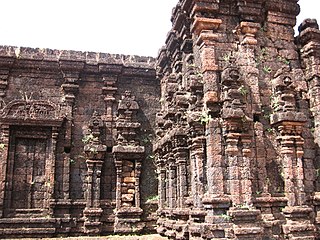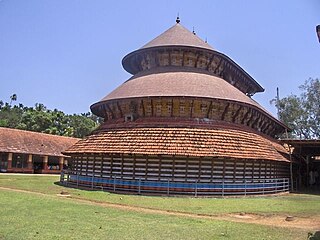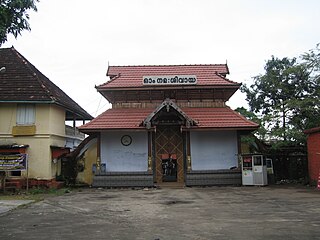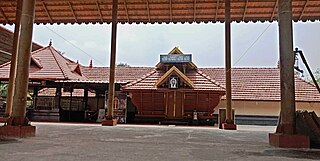
Parashurama, also referred to as Rama Jamadagnya, Rama Bhargava and Veerarama, is the sixth avatar among the Dashavatara of the preserver god Vishnu in Hinduism. He is believed to be one of the Chiranjeevis (Immortals), who will appear at the end of the Kali Yuga to be the guru of Vishnu's tenth and last incarnation, Kalki.

Ayyappan, also called Dharmasastha and Manikandan, is a Hindu deity popular in Southern India. He is considered to be the epitome of dharma, truth, and righteousness and is often called upon to obliterate evil.

Guruvayurappan also often rendered Guruvayoorappan, is a form of Vishnu worshipped mainly in Kerala. He is the presiding deity of the temple, who is worshipped as Krishna in his child form, also known as Guruvayur Unnikkannan. Even though the deity is that of chaturbahu Vishnu, the sankalpam (concept) of the people is that the deity is the infant form of Krishna Only. This form of lord Vishnu is very pleasant.

The Guruvayur Temple is a Hindu temple dedicated to Guruvayurappan, a form of Krishna, located in the town of Guruvayur in Kerala, India. It is one of the most important places of worship for Hindus in Kerala and Tamil Nadu and is often referred to as Bhuloka Vaikuntha. The temple is Classified one among the 108 Abhimana Kshethram of Vaishnavate tradition.

The Rajarajeshwara temple is a Shiva temple located in Taliparamba in Kannur district of Kerala State of India. The temple is regarded as one of the existing 108 ancient Shiva Temples of ancient Kerala. It also has a prominent place amongst the numerous Shiva temples in South India. It had the tallest shikhara amongst the temples of its time. The Rajarajeshwara temple has a top of about 90 tonnes. If any problem is encountered in the other temples of South India, devotees seek a solution in this temple through a prashnam, a traditional method of astrological decision-making. The prashnam is conducted on a peedha outside the temple.

Bhadrakali, is a Hindu goddess She is considered to be the auspicious and fortunate form of Mahakali who protects the good, known as bhadra.
Kollur Mookambika Temple is located at Kollur in Byndoor Taluk of Udupi District in the region of Tulunadu and in the state of Karnataka, India. It is a Hindu temple dedicated to the Mother Goddess known as Mookambika Devi. Mookambika is the union of Adipara Shakthi and Parabramha as the Linga has integrated on its left side "Maha Kali, Maha Lakshmi and Maha Saraswathi". It is situated in the foothills of Kodachadri hills, on the southern bank of Souparnika River. Being situated in the land between Gokarna and Kanyakumari, believed to be created by sage Parashurama. The main deity of the temple is a swayambhu (self-born) jyotirlinga with a golden line cutting it into half, in which the left half represents Tridevis, and the right half represents Trimurtis. Along with this, a four-handed panchaloha idol of Goddess Mookambika is also installed.
Kadappattoor is a small village on the banks of Meenachil river near Pala in Kottayam district of Kerala. Kadappattoor, is located 30 km east of Kottayam. The village life is centered on the Shiva Kadappattoor Mahadeva Temple The population consists of Hindus and Christians.

Madhur Sree Madanantheshwara-Siddhivinayaka Temple is a popular Shiva and Ganapathi temple located 7 km (4.3 mi) from Kasaragod town, on the banks of Mogral river, locally known as Madhuvahini. Though the main deity of this temple is Lord Shiva known as Madanantheshwara, meaning the god who killed Kama, the god of desires, more importance is given to Lord Ganapathi, who is installed facing south in the main sanctum itself. Priests of this temple belong to the Shivalli Brahmin community. Kashi Vishwanatha, Dharmasastha, Subrahmanya, Durga Parameshwari, Veerabhadra and Gulika are the sub-deities of this temple. There is also presence of Goddess Parvati inside the main sanctum.

The Vilwadrinatha Temple is a Hindu temple in Kerala's Thiruvilwamala, which is located in the city of Thrissur.

The Sreevallabha Temple is a highly orthodox Hindu temple dedicated to Sreevallabha, a form of Vishnu. It is one of the oldest and biggest Temples of Kerala and has been a major destination for devotees all over India for centuries. Located in Thiruvalla city, this temple is well known for its architectural grandeur and unique customs which can be found in no other temples. There are stone-wooden carvings and mural paintings inside the temple. Being one among 108 Divya Desams, Sreevallabha temple has been glorified by Alvars and many other ancient works. It is considered to be the vallabha kshethram mentioned in Garuda Purana and Matsya Purana.Kathakali is played daily in the temple as an offering, pushing it to the top in India in terms of places where Kathakali is staged on the largest number of days per year. Vishnu appeared here as Sreevallabha for sage Durvasa and Khandakarnan. Pleased by the prayers of an old Brahmin lady Sreevallabha incarnated as a Brahmachari and killed the demon Thokalaasuran. Later the deity of Sreevallabha worshipped by Lakshmi and Krishna has been installed in the temple in 59 BC. From then till date, the temple follows its worship protocol that is known to be followed nowhere else yet. Sage Durvasa and Saptarishiare said to reach the temple every midnight for worshipping the Lord. The temple governed one of the biggest educational institutions in ancient times and heavily contributed to the cultural and educational developments of Kerala
There are places of worship considered important in the Kannur district. Kannur District is one of the 14 districts in the state of Kerala, India. The town of Kannur is the district headquarters, and gives the district its name.

Janardana Swami Temple is a 2000+ year-old temple situated in the municipality of Varkala city in Thiruvananthapuram district. It is also known as Varkala Temple. Janardana Swami is a form of Vishnu. It is a very well-known temple in Kerala, about 10.9 km west of Kallambalam on NH 66 near the sea, 25 km north of Thiruvananthapuram city, 8 km south of famous backwater destination Kappil and 2 km from Varkala Railway Station,14 km north west of Attingal municipality. It is situated near the Arabian Sea and has been referred to as Dakshin Kashi. The temple is near Varkala Beach, believed to have medicinal properties since the waters wash the nearby medicinal plants. It is also an important Ayurveda treatment center. The temple has an ancient bell removed from a shipwreck, donated by the captain of a Dutch vessel which sank near Varkala without casualties.

Ernakulam Shiva Temple, also known as Ernakulathappan Temple is one of the major temples of Kerala, located in heart of Ernakulam, Kochi,Kerala, India. The temple, dedicated to Lord Shiva, is considered as the city temple, with the presiding deity as the protector of the city, as per local Hindu faiths and traditions. As per the common practice in Kerala, the deity is reverently called Ernakulathappan, which means Lord of Ernakulam. The temple is located within the Durbar Hall Ground. The temple history itself has deep association with history of the city and was one of the 7 royal temples of Kochi Maharajas. The temple is now under administration of Cochin Devaswam Board. The temple in its current form was built under active patronage of Diwan Sri Edakkunni Sankara Warrier in year 1846 and raised it level of a Royal temple in the Kochi Kingdom. The temple is built on 1-acre (4,000 m2) land. The temple is one of the major Shiva temples in Kerala counted along with the Ettumanoor Mahadevar Temple, Kaduthruthy Mahadeva Temple, Vaikom Temple, Chengannur Mahadeva Temple, Vadakkunathan temple, and Sreekanteswaram Mahadeva Temple, Thiruvananthapuram.

Nainativu Nagapooshani Amman Temple [Tamil: நயினாதீவு நாகபூசணி அம்மன் கோயில், romanized: Nayiṉātīvu Nākapūcaṇi Am'maṉ Kōyil - Meaning: Nainativu ; Nagapooshani ; Amman (Goddess)] is an ancient and historic Hindu temple located amidst the Palk Strait on the island of Nainativu, Sri Lanka. It is dedicated to Parvati who is known as Nagapooshani or Bhuvaneswari and her consort, Shiva who is named here as Nayinaar. The temple's fame is accredited to Adi Shankaracharya, a 9th-century Hindu philosopher, for identifying it as one of the prominent 64 Shakti Peethams in Shakti Peetha Stotram and its mention in the Brahmanda Purana. The temple complex houses four gopurams ranging from 20–25 feet in height, to the tallest being the eastern Raja Raja Gopuram soaring at 108 feet high. The temple is a significant symbol for the Tamil people, and has been mentioned since antiquity in Tamil literature, such as Manimekalai and Kundalakesi. The present structure was built during 1720 to 1790 after the ancient structure was destroyed by the Portuguese in 1620. The temple attracts around 1000 visitors a day, and approximately 5000 visitors during festivals. The annual 16-day Mahostavam (Thiruvizha) festival celebrated during the Tamil month of Aani (June/July) - attracts over 100,000 pilgrims. There is an estimated 10,000 sculptures in this newly renovated temple.

Neendoor Subrahmanya Swami Temple is an ancient lord Murugan temple located in the Neendoor, Kottayam district. The Neendoor Subrahanya Swami Temple is a historic site which has brought glory and fame to the local area. Myths say that the Pandavas and the sage Vyasa worshipped at this temple. The deity of the temple is Lord Muruga. Neendoor Subrahmanya Swami Temple hosts the arattu festival, which is celebrated on a grand scale on the Medashasti day in April–May every year. The Ottanarangamala Samarppanam is one of the important rituals of this temple.

Evoor Major Srikrishnaswamy temple is a Krishna temple in Evoor near Haripad, in Alappuzha, Kerala. It is said to have originated five millennium ago following Khandava Dahanam. Temple in its current form is built by Moolam Thirunal.

The Sree Subrahmanya Swamy Temple (Perumthrikkovil) in Haripad, Kerala, is one of the oldest and largest temples in the region. Dedicated to Subrahmanya Swamy, it is also known as Kerala Palani or Dakshina Palani (Southern Palani). According to belief, the temple predates the beginning of Kali Yuga. This temple holds the distinction of being the largest Subrahmanya Swami Temple in Kerala, featuring the longest golden flagpost, known as dhwajastambha (kodimaram in Malayalam). The deity is believed to embody not only Subrahmanya Swamy but also Lord Shiva and Lord Vishnu, making it a highly revered and powerful place of worship.
The town of Muvattupuzha in Kerala, India contains places of worship for Hindus, Syrian Christians and Mappila Muslims.
















